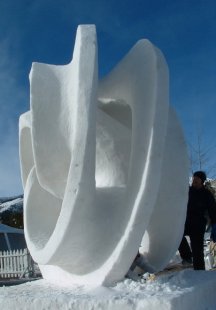Brent Collins has spent more than two decades carving gracefully curvaceous sculptures out of wood. Born of his imagination, rendered in wire and wax, then painstakingly realized in wood in his Gower, Missouri, workshop, each creation demands many weeks of labor.



Collins is not a mathematician, yet his intuition and aesthetic sense have led him to explore patterns and shapes that have an underlying mathematical logic. His creations have a strong sense of natural economy, like that of a soap film spanning a warped wire frame. Indeed, many of his sculptures display the characteristic curves of a minimal surface, as observed in saddle-shaped soap films hanging from wire frameworks. They also surprise the viewer by dramatically changing in appearance from different viewpoints.
Last month, Collins had a chance to realize one such daring, ethereal form on a massive scale, carved from a 20-ton block of hard, packed snow. It happened at the 13th International Snow Sculpture Championship in Breckenridge, Colo., where Collins was a member of the USA-Minnesota team, led by mathematician Stan Wagon of Macalester College in St. Paul, Minn.
This was Wagon’s fifth entry in the prestigious competition. He was joined this time by Collins, veteran participant Dan Schwalbe, a software engineer in Minneapolis, Carlo Séquin, a computer graphics professor at the University of California, Berkeley, and Steve Reinmuth, who operates a foundry in Springfield, Ore.
The team chose a mathematically inspired design that might remind you of an elegant, fanciful propeller–an intricate whirl of twisted and stretched saddle shapes.
This particular design had arisen out of a longstanding collaboration between Collins and Séquin. In the early 1990s, Collins had been working on a series of sculptures in which each piece consisted of a punctured ring of intertwined saddle surfaces. These sculptures can be described as different ways of warping pieces of an infinite mathematical shape called Scherk’s second minimal surface, named for the mathematician Heinrich Ferdinand Scherk (1798–1885).
Intrigued by Collins’ artwork, Séquin had worked with his students to develop an innovative computer program for creating prototypes of such sculptures, allowing a sculptor to try out new designs without having to spend weeks making physical prototypes. Séquin could also send those designs to a three-dimensional prototyping machine, which would produce small models of the sculptures.
In the Breckenridge competition, each four-member snow-sculpting team had 4 1/2 days to shape a 12-foot-high block of snow into its final form. The first task facing Wagon and his team was to carve their block into a giant doughnut (torus), reflecting the sculpture’s underlying fundamental geometry. Because all of the edges of the final sculpture lay on the surface of the torus, the sculptors had to make sure their torus was as accurate as possible.
Séquin had calculated that the finished sculpture would have about 280 feet of edges. That was “by far the most of our 5 years with similar shapes,” Wagon noted. “I think also that we removed more snow for this piece than for any others.”
Wagon ended up having to work overnight to help complete the sculpture in time for judging at 10 AM on Saturday morning, Feb. 1. In the end, “the piece had frozen nicely, and we could stand on its apex and lie in the central tunnel confident in its strength,” Wagon said. Dubbed Whirled White Web, the finished sculpture weighed about 4 tons, and it sat on two lobes about 10 inches wide and 6 feet long. Séquin has an illustrated account of the event at http://www.cs.berkeley.edu/~sequin/SCULPTS/SnowSculpt03/.
After the judging, the team went out for lunch but soon received bad news. The sculpture had collapsed because of the very warm weather at the end of
the sculpting period. “Our failure to adapt by thickening the base was our biggest snow-sculpting error ever,” Wagon admitted. “The sun, perhaps focused and reflected by the sculpture, just melted the support, and once our shape wobbles a bit, it is gone.”
Nonetheless, the USA-Minnesota team captured second place in the competition for the daring beauty and grace of Whirled White Web. It was a fortunate outcome. If the event had ended an hour later, the judges would have seen just an interesting pile of icy rubble.






